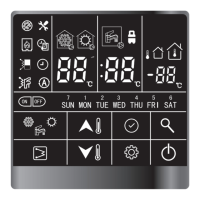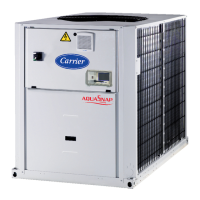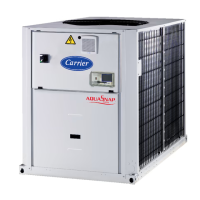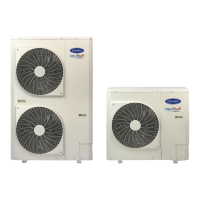39
13.2.2 - Procedure for cleaning the hydraulic circuit
• Open all valves completely (item 19).
• Start-up the system pump.
• Let the pump run for 2 hours consecutively to clean up the
hydraulic circuit of the system (presence of contaminating
solids).
• Perform another reading.
• Compare this value to the initial value.
• A reducing value of the ow indicates that the lters on the
system need to be removed and cleaned. In this case, close
the Shut-off valves on the water inlet and outlet (item 19)
and remove the lters (items 20 and 1) after draining the
hydraulic part of the unit (item 6).
• Remove the air from the circuit (items 5 and 14).
• Repeat until the lter remains clean.
13.2.3 - Procedure for controlling water fow
Once the circuit is cleaned, read the ow value on the user
interface and compare it with design value for the system. If the
value of the ow is greater than the specied value, this indicates
that the overall pressure drop in the system is too low against the
available static pressure generated by the pump.
In this case, close the control valve and read the ow value. Repeat
as necessary until the pressure drop corresponding to the design
ow rate is achieved.
NOTE: If the network has an excessive pressure drop in
relation to the available static pressure delivered by the unit
pump, the nominal water ow cannot be obtained (lower
resulting ow) and the difference in temperature between the
water inlet and outlet of the evaporator will be increased.
To reduce the hydraulic system pressure drop:
• Reduce the pressure drops of individual components
(bends, level changes, valves etc.) as much as possible
• Use the correct pipe diameter
• Do not extend the piping system.
13.3 - Units with hydraulic module and variable-
speed pump - pressure differential control
The system ow is not controlled to a xed value. The ow
rate will be adjusted, by varying the pump speed, to maintain a
system pressure differential value defined by the user. The
pressure sensor at the unit outlet (item 10 in the typical hydraulic
circuit diagram) is used as the means of control.
The system calculates the measured pressure differential value,
compares it with the user-selected set point value and modulates
the pump speed as necessary. The result is:
• an increased ow rate, if a lower value than the set point is
measured,
• an decreased ow rate, if a higher value than the set point
is measured.
This ow rate variation is realised, observing the minimum and
maximum admissible unit ow rates as well as the minimum and
maximum pump supply frequency values.
The pressure differential value maintained can in certain cases
be different from the set point value:
• If the set point value is too high (achieved for a higher ow
rate than the maximum value or a higher frequency than
the maximum value), the system settles at the maximum
ow rate or maximum frequency and this results in a lower
pressure differential than the set point.
• If the set point value is too low (achieved for a lower ow
rate that the minimum value or a lower frequency than the
minimum value), the system settles at the minimum ow
rate or minimum frequency and this results in a higher
pressure differential than the set point.
See with Carrier Service to implement the procedures described
below.
13.3.1 - Procedure for cleaning the hydraulic circuit
Before proceeding, it is advisable to remove any possible
contamination from the hydraulic circuit.
• Start-up the system pump by using the forced start
command.
• Control the frequency to the maximum value to generate a
higher ow.
• If there is a ‘‘Maximum fow exceeded’’ alarm, reduce the
frequency until an acceptable value is reached.
• Read the value of the ow on the user interface.
• Let the pump run for 2 hours consecutively to clean up the
hydraulic circuit of the system (presence of contaminating
solids).
• Perform another reading of the ow and compare this value
with the initial value. A reducing value of the ow indicates
that the lters on the system need to be removed and
cleaned. In this case, close the shut-off valves on the water
inlet and outlet (item 19) and remove the lters (items 12
and 1) after draining the hydraulic part of the unit (item 6).
• Remove the air from the circuit (items 5 and 14).
• Repeat if required the lter remains clean.
13.3.2 - Procedure for controlling the pressure
differential
Setpoint
Once the circuit is cleaned, place the hydraulic circuit in the
conguration for which the unit selection was performed generally
(all valves open and all cooling coils active). Read the value of
the !ow on the user interface and compare it with the theoretical
value of the range:
• If the value of the ow is greater than the specied value,
reduce the pressure differential setpoint on the user
interface to reduce the value of the ow.
• If the value of the ow is lower to the specied value,
increase the pressure differential setpoint on the user
interface to increase the value of the ow.
Repeat until the design pressure drop / ow rate is achieved.
Stop the forced operation of the pump and proceed to the
conguration of the unit for the required control mode.
Modify the control parameters:
- Set water ow control to ‘pressure differential’
- Set the value of the required differential pressure
By default, the unit is congured at the maximum speed (frequency:
50 Hz).
NOTES:
If during controlling, the low or high frequency limits are
reached before reaching the specied ow, keep the pressure
differential value to its lower or higher limit to enter in the
control parameters.
If the user knows in advance the pressure differential value
at the unit outlet to be maintained, this value can be entered
directly as data to be declared. You should not, however,
avoid the sequence of cleaning the hydraulic circuit.
13.4 - Units with hydraulic module and variable-
speed pump - temperature difference control
The temperature probes at the heat exchanger inlet and outlet
(items 8 and 9 in the typical hydraulic circuit diagram) are used
as means of control.
The system reads the measured temperature values, calculates
the corresponding temperature difference, compares it with the
user-selected set point value and modulates the pump speed as
necessary:
• If a higher delta T value than the set point is measured, the
ow rate is increased.
• If a lower delta T value than the set point is measured, the
ow rate is decreased.
13 - NOMINAL SYSTEM WATER FLOW CONTROL

